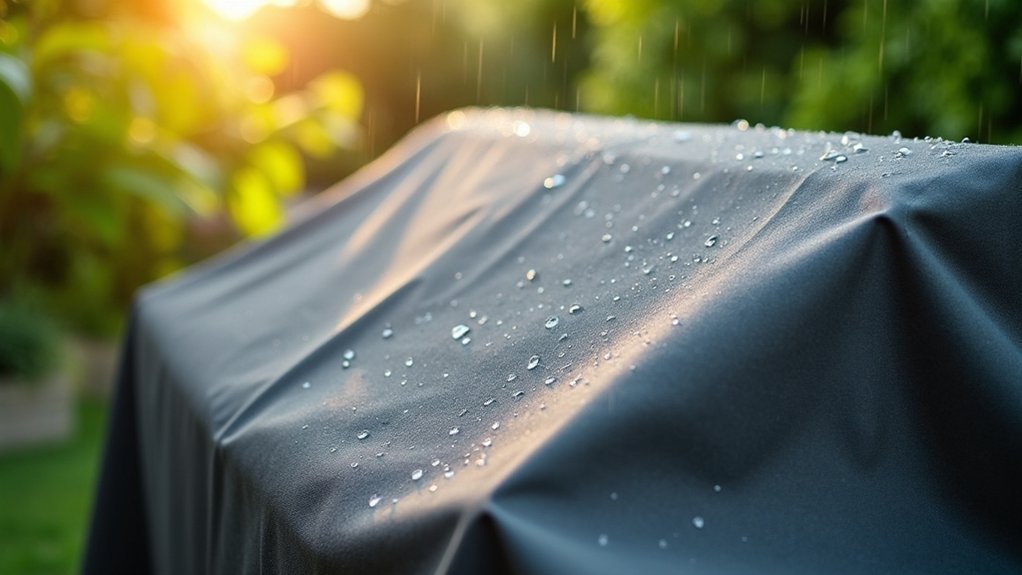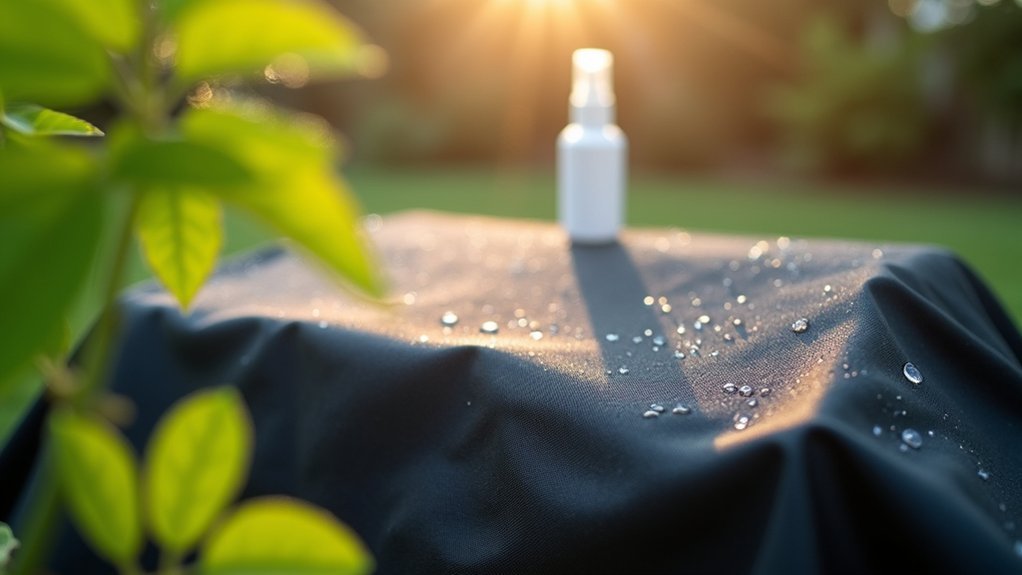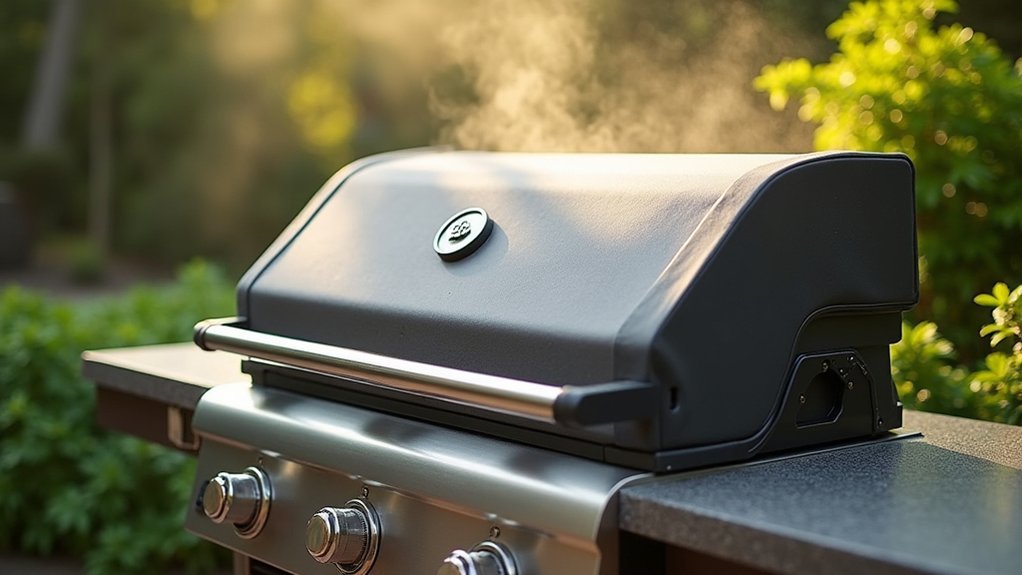You’ll maximize your grill’s protection by choosing vinyl or polyester covers with UV resistance and rip-proof features. Measure your grill accurately to guarantee a snug fit, then secure it with adjustable straps and drawstrings to prevent wind displacement. Apply water repellent spray regularly, especially after heavy rain, and clean your cover frequently while making sure it’s completely dry before storage. Position covers with built-in ventilation and keep your grill slightly elevated for ideal airflow and thorough weather defense.
Choose the Right Waterproof Fabric Material for Maximum Protection

When protecting your grill from the elements, selecting the right waterproof fabric material becomes your first line of defense against rain, UV rays, and harsh weather conditions.
Vinyl offers excellent waterproof properties and superior UV resistance, keeping moisture out while preventing sun damage.
Polyester provides a lightweight, affordable alternative that’s fade-resistant and offers good water protection.
Canvas delivers exceptional durability for harsh weather, though it’s heavier than synthetic options.
Your cover material should include weather-resistant features like rip-proof and anti-fade capabilities for enhanced longevity.
Don’t forget proper ventilation to prevent moisture buildup under your grill cover, which can cause mold and mildew formation that damages both your grill and cover.
Ensure Proper Fit and Secure Fastening Systems
After selecting the perfect waterproof material, you’ll need to focus on achieving a snug, secure fit that locks out moisture and withstands strong winds.
Start by measuring your grill’s width, depth, and height accurately to guarantee proper cover sizing. A well-fitted grill cover prevents moisture buildup and maximizes waterproof protection.
Look for covers with adjustable straps on both sides – these hook-and-loop fasteners secure the cover tightly against wind displacement.
A drawstring feature around the bottom provides additional tightening for that vital snug fit, minimizing water penetration at the base.
Consider custom covers tailored to your grill’s specific dimensions. This secure fastening approach reduces moisture accumulation and enhances overall protection.
Apply Water Repellent Spray for Enhanced Weather Resistance

Even the highest-quality waterproof grill covers benefit from an extra layer of protection through water repellent spray application.
You’ll create a protective barrier that prevents moisture from penetrating the fabric, helping avoid mold and mildew growth. The hydrophobic compounds bond with your grill cover material, causing water droplets to bead up and roll off, enhancing overall weather resistance.
Clean your cover thoroughly before application to guarantee maximum effectiveness and proper adhesion.
Proper cleaning removes dirt and debris that can interfere with spray bonding and reduce the treatment’s protective effectiveness.
You should reapply the spray periodically, especially in humid climates or after heavy rain, to maintain waterproofing capabilities. Consider using silicone water-guard spray to further enhance water repellency.
This simple step extends your cover’s lifespan while keeping your grill safe from rust and corrosion, assuring long-term protection against harsh weather conditions.
Regular Maintenance and Cleaning for Long-Lasting Performance
Protective treatments work best when you maintain your grill cover through consistent cleaning and care routines.
Regular maintenance starts with wiping down your cover using a cloth to remove dirt and debris that can compromise its ability to repel water. Never place the cover on a wet grill, as trapped moisture leads to rust and corrosion.
Inspect your cover regularly for holes or rips that reduce its effectiveness. When damage occurs, replace it immediately to prevent the cover from losing decent protection capabilities.
For non-machine washable covers, let them dry completely in sunlight after cleaning to eliminate lingering moisture buildup that causes deterioration. This routine maintenance guarantees your grill cover continues providing reliable weather protection.
Strategic Positioning and Ventilation to Prevent Moisture Buildup

Proper positioning of your grill cover creates the foundation for effective moisture management and long-term protection.
You’ll want to choose covers with built-in ventilation features that allow air circulation while shielding against debris. Position your grill cover to facilitate airflow and prevent it from becoming a moisture trap that damages your equipment.
Always verify your grill’s completely dry before covering it, as trapped moisture accelerates corrosion regardless of weather conditions.
Elevate your grill slightly off the ground to promote air circulation around the base. Regularly adjust the cover’s positioning to maintain a snug fit without excessive tightness. This balance minimizes wind displacement while allowing essential airflow.
Proper ventilation prevents mold and mildew buildup, greatly extending the life of your grill.
Frequently Asked Questions
Will a Grill Cover Protect From Rain?
Yes, you’ll get excellent rain protection with a quality grill cover. Choose waterproof Oxford fabric with adjustable straps and drawstrings – they’ll keep your grill completely dry and prevent rust during storms.
How to Prevent Grill Cover From Ripping?
Choose durable Oxford fabric covers that fit your grill’s exact dimensions. Secure them tightly with adjustable straps, avoid sharp edges, don’t cover hot grills, and regularly inspect for wear to prevent ripping.
Can I Leave My Grill Outside With a Cover?
Yes, you can safely leave your grill outside with a cover. Confirm it’s completely cool before covering, use a quality waterproof cover with secure straps, and check periodically for damage or moisture buildup.
What’s the Best Material for a Grill Cover?
You’ll want rip-proof polyester for the best balance of durability, waterproofing, and affordability. It resists fading, handles various weather conditions well, and won’t trap moisture like vinyl can.





Leave a Reply